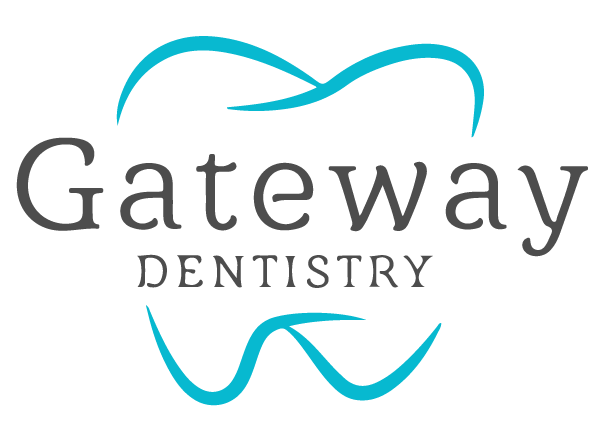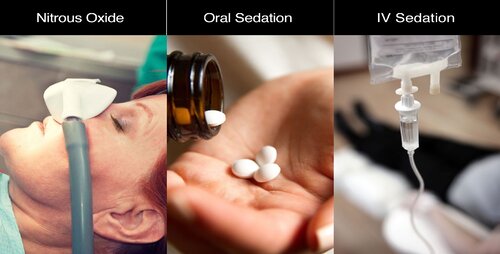TYPES OF DENTAL SEDATION
There are several types of sedation dentistry available. When you visit Gateway Dentistry we will review many factors, including your medical history and oral health needs, to determine which type of sedation will be best for you.
Inhalation sedation (nitrous oxide or “laughing gas”)
Oral sedation (anxiolysis)
Intravenous (IV) sedation
INHALATION SEDATION (NITROUS OXIDE OR “LAUGHING GAS”)
Nitrous oxide or “laughing gas” is the most common method of sedation that dentists use during dental treatment. A small inhaler mask is placed over your nose to administer a mixture of oxygen and nitrous oxide. You will be able to respond to the dentist or hygienist during the procedure and you will be aware of the treatment, although you will remain warmly relaxed. Inhalation sedation is a good option for mild to moderate levels of dental anxiety. It also reduces or eliminates gagging in patients who have an extreme gag reflex. There is no recovery time since the effects of the gas go away as soon as it’s turned off.
ORAL DENTAL SEDATION (ANXIOLYSIS)
With oral dental sedation, you will experience a relaxed, comfortable, and safe experience, with little or no anxiety. The goal is not to create sleep, and you will still have awareness of what is going on; however, with oral dental sedation, you will feel like you’ve had a good, relaxing rest throughout the entire appointment. During your sedation interview, you and your dentist will discuss which oral medication will work best for you, taking into account your medical history, the dental procedures scheduled, and the length of your appointment. You will receive written instructions to follow before and after your appointment that will help you have a safe and effective sedation experience. And, most importantly, you will need a responsible companion to drive you to and from your appointment and stay with you at home until you are completely recovered (usually 4-10 hours).
INTRAVENOUS (IV) DENTAL SEDATION
During intravenous (IV) dental sedation, anti-anxiety, and anesthesia medications are precisely administered into your bloodstream. Within seconds, you will be completely relaxed and at ease, while fully monitored for safety and comfort. As with all forms of sedation, you will also be given a local anesthetic to ensure your complete comfort during treatment. For your safety, you will always need to have a responsible adult drive you to and from your IV sedation appointment and stay with you for 24 hours. You will receive additional written instructions during your sedation consultation, and it is important that you follow them all.
INTRAVENOUS (IV) SEDATION
Some dental procedures may call for a deeper level of sedation for fearful patients. IV sedation is a proven method that makes dental care possible for everyone. At Gateway Dentistry, we’ve incorporated sedation techniques that few clinics offer. During IV sedation, sedative medication flows through the bloodstream as treatment occurs. It’s unlikely you’ll remember anything about your visit as the medication gently blocks your memory of the procedure. IV sedation leads to procedures that seem to fly by with more treatment completed in one appointment. Our highly-trained team monitors you for safety from start to finish.
Dental fear doesn’t need to dictate your dental health. IV sedation eliminates even the highest level of anxiety.
The calming medication enters your system before starting any treatment
In our office, IV sedation is Administered by Lifeguard Anesthesia in advanced anesthesia techniques.
During IV sedation you’ll be monitored by the best technology and expertise. Before you know it, you’re heading home to rest.
We look forward to discussing your sedation needs and creating a personalized plan that fits your comfort level. If IV sedation feels like the best choice, we’ll explore scheduling that allows you to start enjoying the benefits of optimal dentistry.
FAQS
IS A CROWN OR BRIDGE RIGHT FOR ME?
If you have a tooth that is damaged or decayed, but still intact, a dental crown may be right for you. If your tooth is missing, but its former position is surrounded by other tooth structures, a bridge may be the solution for you. Schedule an office consultation to determine whether you could benefit from crowns or bridges.
WHAT SHOULD I EXPECT WHEN I HAVE MY CROWN OR BRIDGE PLACED?
If you are a candidate for a crown or bridge, your teeth will be reduced to ensure a proper fit. An impression will then be taken of your bite and used to fabricate a mold for the crown or bridge. If you are choosing porcelain prosthesis, its color will be matched to the natural shade of your other teeth. If a dental lab is making your crown or bridge, you may be fitted with a temporary restoration until the permanent one is ready for placement.
DO I NEED TO FOLLOW ANY POST-TREATMENT CARE GUIDELINES?
Your teeth will need time to heal following the crown and bridge placement process, so it is normal for you to experience some sensitivity – especially to hot and cold. Additionally, you may experience soreness in the gums surrounding your restorations, though this is usually manageable with ibuprofen and should subside within a few days.

